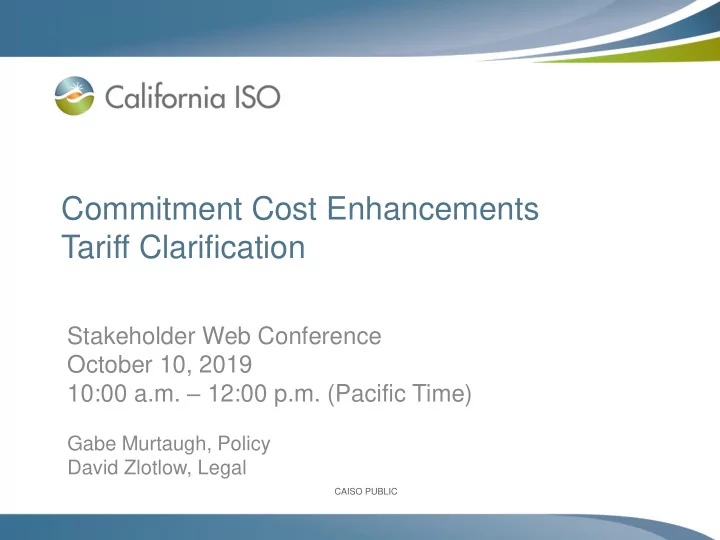

Commitment Cost Enhancements Tariff Clarification Stakeholder Web Conference October 10, 2019 10:00 a.m. – 12:00 p.m. (Pacific Time) Gabe Murtaugh, Policy David Zlotlow, Legal CAISO PUBLIC CAISO PUBLIC
Discussion Topics • CCE3 background – Use limited resources – Conditionally available resources – Run of river resources • Bidding obligations • Applicability of RAAIM and obligations • Notification of outages • Tariff clarifications CAISO PUBLIC Page 2
The objective of CCE3 was to receive greater market participation from use limited resources • Resources that have a limited amount of energy, starts or run hours can qualify as use-limited – A gas resource with a certain number of starts – A storage resource with a pond that provides a limited amount of stored energy • Concern was ISO might deplete these use limitations before an optimal time of use • Use-limited resources are eligible for a use-limited default energy bid adder – Adders calculated from expected market revenues so that the market dispatches the resources considering the value of its use limitations CAISO PUBLIC Page 3
Opportunity cost example for energy limitations • Consider a hydro resource that can only be dispatched 3 hours during one day – Highest prices are $70, $60, and $55/MWh – Resource has ~$0/MWh marginal operating costs – If resource dispatched in hour when price is $20 has it could be dispatched in hours before the price reaches $55/MWh • The opportunity cost for a resource to run, is then $55/MWh, what it would be giving up if run during another hour • Applying opportunity cost adders, that ensure are at least $55/MWh, can create an optimal dispatch for the resource driven by market price signals CAISO PUBLIC Page 4
Applying opportunity cost bid adders allows for these resources to provide high levels of flexibility • With the appropriate bid adders applied to use limited resources, these resources will be able to bid into the real-time market 24x7 – Resources are subject to RAAIM if not bidding into the market – These resources remain exempt from RA bid insertion • Risk: if prices are higher than modeled, then use limited resources could be used too early – ISO offers use limited resources RAAIM exempt outage cards to manage these issues CAISO PUBLIC Page 5
Not all limitations can be modelled with the use limited framework • Some resources are not able to bid into the market during specific times – Gas resource that cannot operate in certain hours because of noise restrictions – Hydro resource with regulatory water flow restrictions • These constraints are different and distinct from use limitations • Conditionally available resources (CARs) were created to account for these resources – Opportunity costs cannot capture conditionally available limitations CAISO PUBLIC Page 6
Conditionally available resources are required to bid into the market for RA obligations • Conditionally available resources are required to bid in full resource adequacy capacity – Conditionally available capacity is not the bidding requirement – Outage cards are available for resources with conditional available reasons for unavailable capacity • Applicable RAAIM penalties will apply if a conditionally available resource is unable to provide energy to the market because of an applicable condition – For example: Noise limitations are in place during an availability assessment hour • Resources can potentially be use limited and conditionally available CAISO PUBLIC Page 7
Run of river hydro resources will be treated like variable energy resources (VERs) • Run of river resources cannot influence their output – Resources are generally price takers in the market, but may be able to ramp down in response to price signals – I.e. A run of river resource with 10 MW of capacity may be only able to produce 7 MW for a specific hour • Like VER resources, run of river resources will need to transmit data to the ISO on how much they are capable of generating in advance of the resource running – The ISO will not be generating forecasts for these resources CAISO PUBLIC Page 8
Run of river resources are not subject to RAAIM because capacity is calculated by historic output • Like variable energy resources, run of river resources are not subject to RAAIM • Run of river resources will have a historic output methodology to calculate capacity values for the resources based on past availability – Resource that are online more will have higher future capacity value • These resources can apply for flexible status, if the resource is able to ramp down from forecasts • Going forward the ISO may apply an ELCC calculation for these resources to calculate RA credit – New counting conventions may account for low hydro years/low snowpack, so that hydro resources are not over-valued CAISO PUBLIC Page 9
Summary of tariff clarifications and amendments • Clarifying section 40.6.4 so that the RA obligation to bid “expected available Energy” applies only to CARs – Hydro, pumping load, and non-dispatchable resources must register as CAR if they need section 40.6.4 • Section 40.9.2(b)(1)(C) creates RAAIM exemption for run- of-river hydro and Appendix A defines run-of-river • Section 40.9.3.1(b)(2) clarifies that CARs are assessed RAAIM based on their shown RA capacity during AAHs • Non-substantive clarifying edits in sections 40.9.3.6.4 and 40.9.3.6.5 on RA substitution • Clarifications in 40.10.4 on flexible capacity processes CAISO PUBLIC Page 10
Next Steps • Stakeholder written comments requested by October 14, 2019 – Submit to initiativecomments@caiso.com – All related meeting material is available at: http://www.caiso.com/informed/Pages/MeetingsEvents/Miscellan eousStakeholderMeetings/Default.aspx CAISO PUBLIC Page 11
Recommend
More recommend